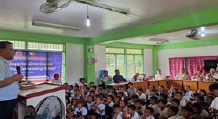
TACLOBAN CITY- Pedro Cahindo, Jr., swears that their village in San Jose District could have more deaths when this city was pummeled by Super Typhoon ‘Yolanda’ exactly seven years ago.
But because of the mangrove forest along the shore in their village in Barangay 83(Paraiso), the more than 2,800 residents were saved from the storm surge that comes with the massive typhoon.
However, 23 residents of the village died due to Yolanda which generated a deadly 20-feet storm surge coming from Cancabato Bay which rings San Jose district, considered the worst-hit area of the city due to the world’s strongest typhoon to hit inland.
“Our mangroves saved our lives. Without them, the storm surge could prove to be more deadly. The mangroves helped slow down the gushing of the water down to our houses,”Cahindo, who was a village councilor at that time, said.
Unfortunately, the mangroves that saved the lives of the villagers, could not withstood the powerful storm surge as many of these trees were damaged, even beyond rehabilitation.
But the villagers, knowing the benefit of the mangroves during the Nov.8,2013 catastrophe, decided to rehabilitate their mangrove forest by planting again sometimes in 2015.
“We are thankful to these mangroves and there is no way for us not to rehabilitate our mangrove forest knowing that these will save us again from a natural calamity like typhoon,” Cahindo said.
And now five years later, the more than seven hectares mangrove cover of Brgy.51 appears to have been completely restored and in full life and now thriving with fishes and crabs.
Cahindo said that the rehabilitation of their natural barrier against flooding or storm surge composed of more than 70,000 mangroves trees mostly of ‘meyapi’ variety, is their way of helping the environment and as part of their risk reduction management during a calamity situation.
“Our people here in the village are aware on the usefulness of our mangrove forest. That it is not only for our protection from a typhoon but even in preserving our marine lives like fish and crabs which now thrives there,” he said.
Girlie Obillo,43 and mother to seven children, said that she too was thankful that their village have mangrove cover that helped them during the onslaught of Yolanda and in the succeeding typhoons.
“While we’re hit by the storm surge, its impact was not that strong because the mangroves protected us. They helped slow down the rush of the water from the sea,” she said.
Obillo said that she and the rest of the families living close to the mangrove forest are aware on the usefulness of the mangrove forest.
Thus, she said, no one dare cut the mangroves. “We know it is illegal to do. And why would we destroy something that protects us from a calamity?” she said.
Cutting of mangroves is illegal in the country unless one secures a permit from the Department of Environment and Natural Resources (DENR).
Danilo Elias, 62, who was one of the residents of the village who helped plant more than 500 propagules back in the 1990s covering around four hectares, said that they are thankful that the villagers are aware the benefit of these mangroves.
“From their experience in Yolanda, they have learned that these mangroves could protect us from a calamity like massive flooding. That is why, they don’t cut any of our mangroves here. They are helping us protect the mangroves as they know that mangroves help mitigate the impact of flooding brought by typhoon,” he said.
He, however, said that during their clearing of mangroves, the cut trees are given to the community where they can use them as fire woods or turned into charcoal which they could even sold.
The DENR, noting the multi-purpose of mangrove are encouraging local government units to have their own communal mangrove forest, especially in ‘mangrove-endowed municipalities or cities.’
Mangroves have been proven to be a strong and natural barrier against storm surge or flooding.
“Initiatives made by local communities are most welcome and appreciated by the DENR,” Maita Reina Sucgang, DENR regional information officer, said.
When Yolanda pummeled Brgy.83, almost 80 percent of their already old grown mangrove trees were destroyed.
Again, with the aid of DENR and an international group, OISCA (Organization for Industrial Spiritual and Cultural Advancement International) which is into agriculture and environmental conservation and restoration, a group of 28 men and women of the village revived their mangrove forest back in 2015 by removing the dead mangrove and planting 3,000 propagules.
Several scientists and experts have claimed that Yolanda was a climate change-induced typhoon that claimed more than 6,000 lives, affecting 4.1 million residents, and damaging more than one million homes, mostly from Eastern Visayas.
In Tacloban alone, considered as ground zero of the mammoth typhoon, more than 2,200 people were confirmed to have died, turning the once bustling city into a deserted and God-forsaken area.
In Guiuan town, where Yolanda made its first landfall before Yolanda, packing a wind of 295 kph and gusts as 360 kph, before it barreled its way to Tacloban City, the people there have learned their hard lesson, Mayor Annaliza Gonzales Kwan said.
The town mayor said that this kind of attitude was evident when Super Typhoon ‘Rolly’ threatened Eastern Visayas. The super typhoon struck Bicol Region.
“The people of Guiuan have learned their lesson after Yolanda. The Guiuanons, whenever there is a bad weather, follow weather forecasts in radio or in television. And if there is a need, they themselves evacuate from their homes to safer place,” Kwan said.
(JOEY A. GABIETA)



